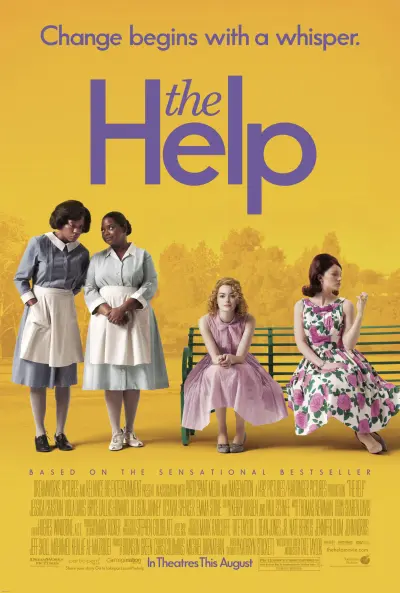
Set against the backdrop of the Civil Rights Movement in the 1960s, The Help offers an evocative portrayal of the lives of African-American maids working in White households in Jackson, Mississippi. The narrative centers on three women – Aibileen Clark, Minny Jackson, and Skeeter Phelan. Aibileen is a wise and compassionate maid who becomes the reluctant storyteller of her experiences; her best friend Minny is fiercely outspoken, yet bound by the secrets that link her to her employers; and Skeeter, a young white woman and the daughter of a local family, returns home with aspirations to become a writer.
The plot intricately weaves the private tales of these characters as Skeeter embarks upon a secretive endeavor to document the testimonies of the Black maids, which culminates in the composition of a book aptly titled "Help". This initiative proves to be a cathartic undertaking, granting the women a platform to voice their sadness and frustrations amidst the absurd and unjust societal conventions they face. The story thoughtfully examines the dynamic between these maids and the families for whom they work—a complicated entanglement of close-knit care and overarching power imbalances.
Though the relationship dynamics provide the story's foundation, The Help is explicitly punctuated by themes of racism and social inequality, highlighting the maids' quiet fortitude and tenacity as they traverse a societal landscape bent on devaluing their identities. The film adeptly unveils the coded language and hypocrisy that serve to sustain deeply rooted prejudice. A compelling discourse unfolds on the intersection of personal hardships with the political landscape, illustrating that defiance against this dichotomy can precipitate significant social reform.
Complementing the film's weightier themes are instances of humor and congeniality, primarily emanating from Minny and the renowned "chocolate pie" incident—a cunning and humorous symbol of resistance towards her maltreating employer. These instances of levity provide a necessary balance to the serious backdrop of the movie and yield a multi-dimensional depiction of the civil rights period from the viewpoint of Black women.
The Help also probes the concept of storytelling as a subversive and truth-revealing act. Skeeter's efforts to amplify the often-muted voices of the maids confront the prevailing norms, while the narrative itself highlights the formidable influence of the written word and the potency of personal stories in combating pervasive discrimination. It posits that the bravery inherent in recounting one's truth has the potential to ignite societal change.
Ultimately, The Help transcends its status as a mere historical drama; it stands as a poignant reminder of the enduring fight for egalitarianism and the essential roles of compassion and solidarity. Although the film has drawn criticism for its treatment of race relations and the "white savior" narrative trope—potentially overshadowing the genuine adversities faced by Aibileen and Minny—it nonetheless serves as an impetus for discourse regarding the lingering impacts of segregationist mindsets and the persistent power dynamics within American society. The narrative's personification of hope, empowerment, and the indispensability of giving a voice to the voiceless continues to resonate with viewers well beyond the ending credits.
The plot intricately weaves the private tales of these characters as Skeeter embarks upon a secretive endeavor to document the testimonies of the Black maids, which culminates in the composition of a book aptly titled "Help". This initiative proves to be a cathartic undertaking, granting the women a platform to voice their sadness and frustrations amidst the absurd and unjust societal conventions they face. The story thoughtfully examines the dynamic between these maids and the families for whom they work—a complicated entanglement of close-knit care and overarching power imbalances.
Though the relationship dynamics provide the story's foundation, The Help is explicitly punctuated by themes of racism and social inequality, highlighting the maids' quiet fortitude and tenacity as they traverse a societal landscape bent on devaluing their identities. The film adeptly unveils the coded language and hypocrisy that serve to sustain deeply rooted prejudice. A compelling discourse unfolds on the intersection of personal hardships with the political landscape, illustrating that defiance against this dichotomy can precipitate significant social reform.
Complementing the film's weightier themes are instances of humor and congeniality, primarily emanating from Minny and the renowned "chocolate pie" incident—a cunning and humorous symbol of resistance towards her maltreating employer. These instances of levity provide a necessary balance to the serious backdrop of the movie and yield a multi-dimensional depiction of the civil rights period from the viewpoint of Black women.
The Help also probes the concept of storytelling as a subversive and truth-revealing act. Skeeter's efforts to amplify the often-muted voices of the maids confront the prevailing norms, while the narrative itself highlights the formidable influence of the written word and the potency of personal stories in combating pervasive discrimination. It posits that the bravery inherent in recounting one's truth has the potential to ignite societal change.
Ultimately, The Help transcends its status as a mere historical drama; it stands as a poignant reminder of the enduring fight for egalitarianism and the essential roles of compassion and solidarity. Although the film has drawn criticism for its treatment of race relations and the "white savior" narrative trope—potentially overshadowing the genuine adversities faced by Aibileen and Minny—it nonetheless serves as an impetus for discourse regarding the lingering impacts of segregationist mindsets and the persistent power dynamics within American society. The narrative's personification of hope, empowerment, and the indispensability of giving a voice to the voiceless continues to resonate with viewers well beyond the ending credits.

